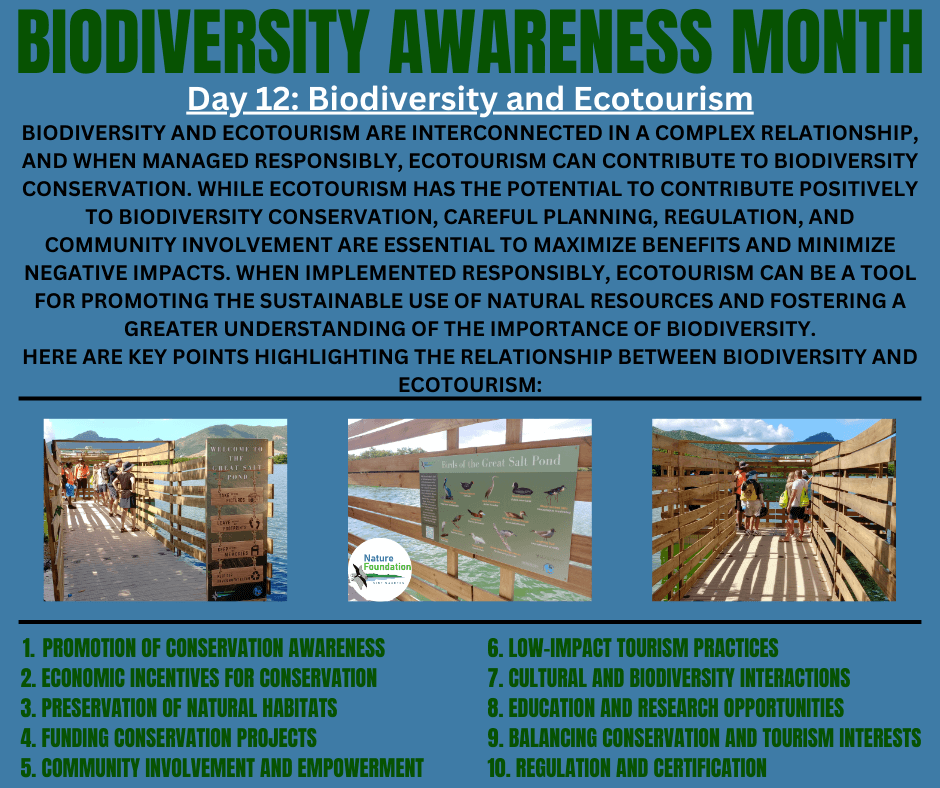Biodiversity month day 12: Biodiversity and Ecotourism
Biodiversity and ecotourism are interconnected in a complex relationship, and when managed responsibly, ecotourism can contribute to biodiversity conservation.
The St. Maarten Hospitality & Trade Association supports the March Biodiversity awareness month organized by the Nature Foundation in an effort to help protect St. Maartens nature and biodiversity. Todays topic: Biodiversity and Ecotourism
Here are key points highlighting the relationship between biodiversity and ecotourism:
1. Promotion of Conservation Awareness: Ecotourism, when done right, can raise awareness about the importance of biodiversity and ecosystems. Visitors to ecotourism destinations often gain a deeper appreciation for nature, fostering a sense of responsibility towards conservation.
2. Economic Incentives for Conservation: Sustainable ecotourism practices can generate economic benefits for local communities and governments. This economic incentive can create a direct link between the conservation of biodiversity and the well-being of the local population, encouraging the preservation of natural habitats.
3. Preservation of Natural Habitats: Ecotourism initiatives often prioritize the protection of natural habitats and ecosystems. Responsible tourism operators work to minimize environmental impact, reduce habitat disturbance, and establish guidelines to protect sensitive areas, contributing to the conservation of biodiversity.
4. Funding Conservation Projects: Revenues generated from ecotourism activities, such as park fees and guided tours, can be reinvested in biodiversity conservation projects. This funding can support research, habitat restoration, anti-poaching efforts, and the overall management of protected areas.
5. Community Involvement and Empowerment: Engaging local communities in ecotourism initiatives can empower them to take an active role in biodiversity conservation. By involving local residents in tourism operations, communities may develop a vested interest in preserving their natural surroundings and wildlife.
6. Low-Impact Tourism Practices: Responsible ecotourism prioritizes low-impact practices to minimize negative effects on ecosystems. This includes adhering to designated trails, respecting wildlife viewing guidelines, and using sustainable infrastructure to reduce the ecological footprint of tourism activities.
7. Cultural and Biodiversity Interactions: Ecotourism often provides opportunities for cultural exchanges between visitors and local communities, showcasing the interconnectedness of cultural diversity and biodiversity. This can lead to the appreciation of traditional knowledge and practices that contribute to biodiversity conservation.
8. Education and Research Opportunities: Ecotourism provides platforms for environmental education and scientific research. Visitors can learn about local ecosystems, species, and conservation challenges, while researchers can gather valuable data to contribute to biodiversity studies and monitoring.
9. Balancing Conservation and Tourism Interests: Challenges arise when balancing the economic benefits of ecotourism with the need to protect sensitive environments. Striking a balance that ensures the long-term sustainability of both tourism and biodiversity conservation is crucial.
10. Regulation and Certification: Establishing and enforcing regulations for ecotourism activities, along with certification programs, can help ensure that tourism operations adhere to sustainable and responsible practices, minimizing negative impacts on biodiversity.
In summary, while ecotourism has the potential to contribute positively to biodiversity conservation, careful planning, regulation, and community involvement are essential to maximize benefits and minimize negative impacts. When implemented responsibly, ecotourism can be a tool for promoting the sustainable use of natural resources and fostering a greater understanding of the importance of biodiversity.
Back to the Visit St Maarten Main page

